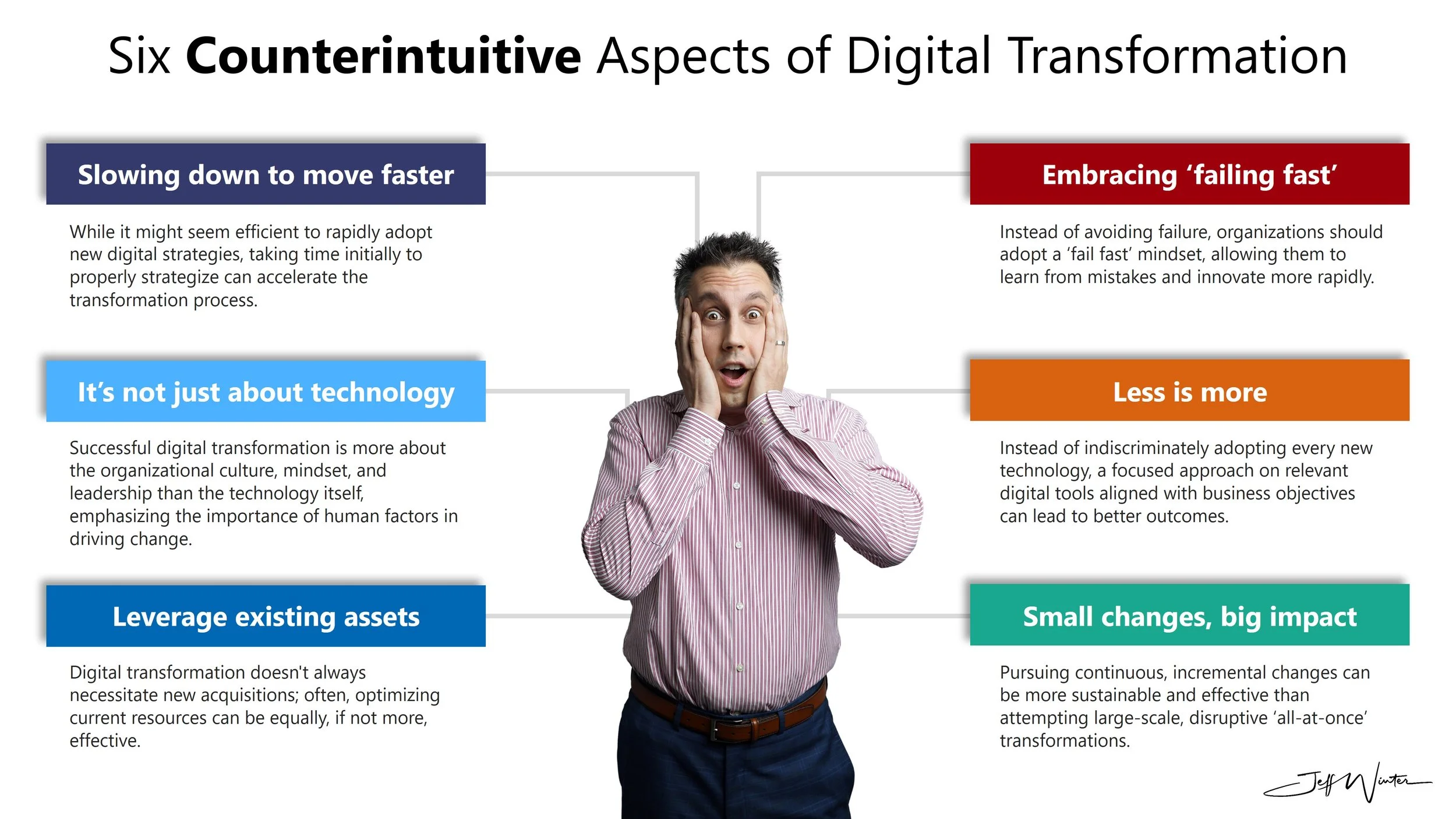Six Counterintuitive Aspects of Digital Transformation
Dare to challenge the status quo? Let’s unravel the six counterintuitive aspects of digital transformation that prove sometimes, the road less traveled leads to greater success.
Six Counterintuitive Aspects of Digital Transformation:
Slowing down to move faster:
At first glance, rushing to implement new digital strategies seems like the way to go to stay ahead. However, taking the time to thoroughly plan and strategize at the beginning can lead to faster and more efficient transformation in the long run. This approach ensures that you’re not just adopting new technologies but integrating them in a way that aligns with your overall business goals, avoiding costly missteps and reworks.Practical example: Conduct a comprehensive evaluation of your production lines to pinpoint exactly where digital tools can offer the most immediate benefits. It’s like measuring twice and cutting once – saves a ton of headaches down the road!
It’s not just about technology:
Many believe that digital transformation is all about having the latest and greatest technology. However, the true drivers of successful transformation are the organizational culture, mindset, and leadership. It’s the people in the organization who use the technology and drive change. Therefore, fostering a culture that embraces change and innovation is crucial. Leadership must support and champion these efforts to create an environment where technology can truly thrive.Practical example: Involve team leaders and operators in decision-making processes for digital implementations. Their on-ground insights are invaluable and ensure everyone’s on board. Think of it as getting your crew’s buy-in before setting sail.
Embracing 'failing fast':
Traditionally, failure is something to be avoided at all costs. In the context of digital transformation, however, adopting a 'fail fast' mindset is beneficial. This means being open to experimentation and learning from mistakes quickly. By doing so, organizations can iterate rapidly and innovate more effectively, turning small setbacks into valuable learning opportunities.Practical example: Try piloting new digital solutions in one department or aspect of production first, and iterate based on the results. It’s like testing the waters before diving in – smarter and safer.
Less is more:
With the vast array of digital tools available, it’s tempting to adopt as many as possible. However, focusing on a few relevant technologies that align with your business objectives can lead to better outcomes. This focused approach ensures that the tools you adopt are fully utilized and integrated, rather than having a plethora of underused technologies.Practical example: Don’t try to analyze every single data point from a manufacturing process. Focus on key performance indicators (KPIs) that directly influence product quality and production efficiency. It’s like using a flashlight in the dark instead of lighting up the whole forest.
Leveraging existing assets:
There’s a misconception that digital transformation requires massive new investments in technology. In reality, optimizing and upgrading existing assets can be just as effective. This approach maximizes the value of current resources and often results in quicker returns on investment.Practical example: Upgrading an existing machine monitoring system can offer more immediate benefits than investing in an entirely new platform. It’s like giving your old car a tune-up instead of buying a new one – cost-effective and efficient.
Small changes, big impact:
Large-scale transformations are often seen as the hallmark of digital success. However, pursuing continuous, incremental improvements can be more sustainable and effective. Small, consistent changes can collectively lead to significant advancements without the disruption that comes with massive overhauls. This approach ensures steady progress and adaptability to changing conditions. Be sure not to confuse continuous improvement with continuous change. It’s the little things that add up to big resultsPractical example: Implement small tweaks to digital monitoring systems or machine algorithms to improve efficiency, rather than overhauling an entire production line at once.

